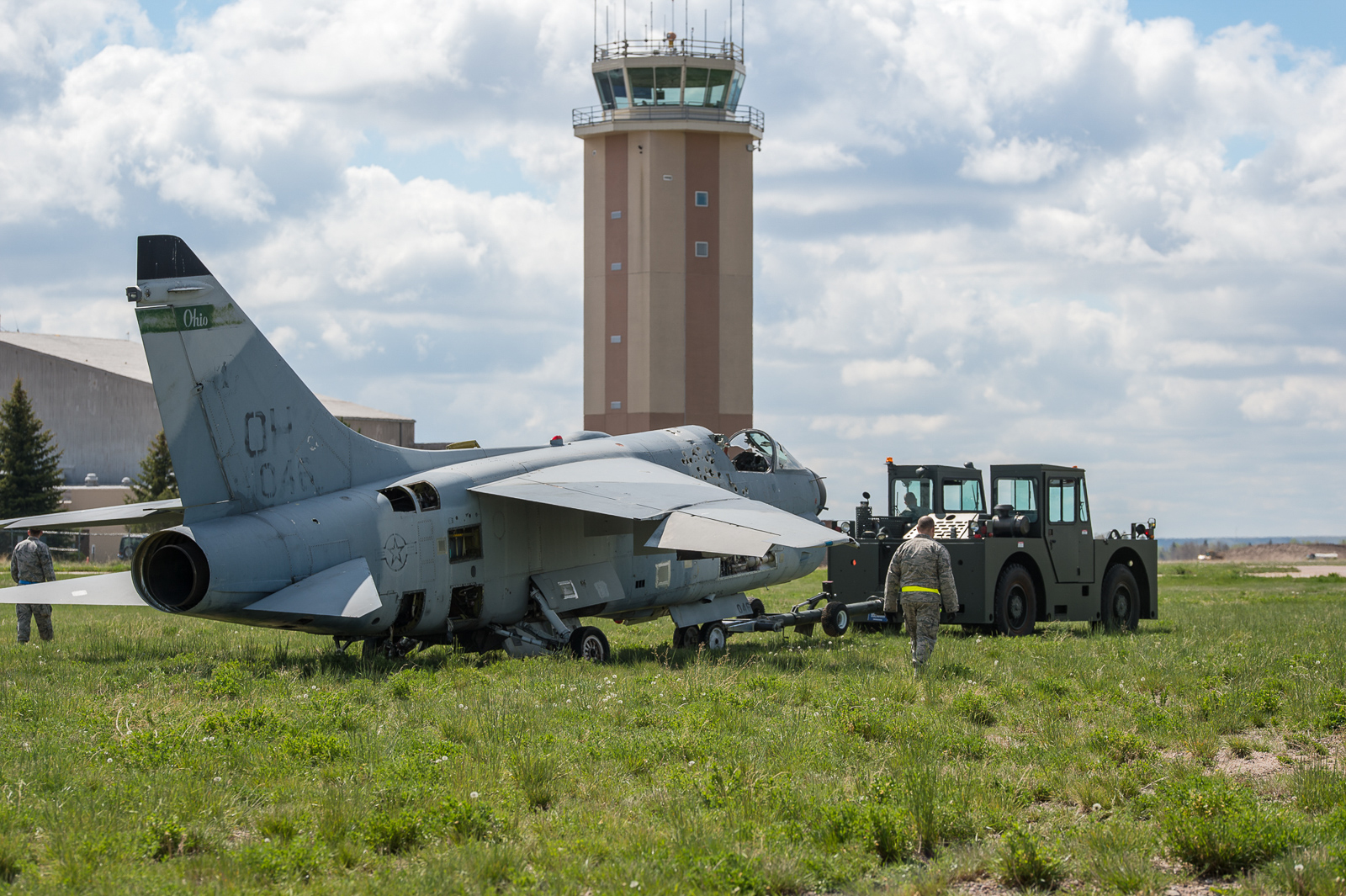When the U.S. military retires an aircraft, it doesn’t always end up in a scrap yard once its flying days are over. A lucky few end up in museums, of course, but sometimes the airframe lingers on, earning its keep as a static training aid. One such aircraft is a former U.S. Air Force LTV A-7D Corsair II, serial 70-1046. Nearly two decades after the United States retired their A-7 fleet, this Corsair II still helps the next generation of warfighters learn their trade with the Air National Guard in Cheyenne, Wyoming. We recently came across a fascinating series of photographs showing ‘046 in a training exercise designed to simulate an aircraft which has run off the runway. The recovery crew then practice the techniques required to recover the airframe safely while also minimizing the possibility of further damage. In this sequence you will see airmen from the 153rd Maintenance Group’s Crash Damage or Disabled Aircraft Recovery (CDDAR) team using inflatable rubber bladders to gently lift the nose of the stranded Corsair from the mud, allowing them to roll her back onto the concrete surface.
In an article released by the 153rd Airlift Wing, Wyoming Air Guard, the exercise was described in detail as follows…
Flying units, like the 153rd Airlift Wing, Wyoming Air National Guard, are required by the Air Force to maintain CDDAR capability. This is broken down into two phases – initial response and recovery.
The maintenance group CDDAR team is responsible for the latter – recovery – which includes coordinating efforts to move the damaged or disabled aircraft to a parking or storage area.
The specialized team of maintainers is comprised of: fuel systems, avionics, hydraulic, structural, propulsion and electro-environmental specialists; aerospace ground equipment mechanics; and aircraft crew chiefs. Every year, the CDDAR team practices responding to damaged or disabled aircraft that have blown tires upon landing, veered off the runway, or crashed.
“As a team, we really enjoy coming out here,” said Tech. Sgt. Stephen Palso, 153rd CDDAR chief. “We have some new equipment and some additional equipment coming, so this year, we set up a scenario which we haven’t been able to do in the past – a scenario that will let us use the new equipment.”
Palso gathered the full CCDAR team for the exercise and briefed them of the situation. In order for the aircraft to be towed, the maintainers had to stabilize the aircraft with a tether and make sure the structure and gears would allow air bag jacking. Several air bags were used for stability and to jack the front landing gear. Air manifolds were set up for the front and rear of the aircraft and connected to individual air bags. After jacking the aircraft, team members installed steel planking to support the forward gears and towed the aircraft out of the mud.
“This was the first time for me doing recovery training. My job was to help set up air bags and operate the manifold,” said Senior Airman Dakota Difrancesco, 153rd Aircraft Maintenance Squadron crew chief. “My normal job always has some sort of data and you are going to follow the book. When a plane crashes or runs of the runway into mud, you don’t always respond in the same way.”
“The whole concept of CDDAR is based on teamwork,” said Maj. Carl Johansen, 153rd Maintenance Squadron commander. “I am proud of the team for their many months of planning and hard work. It took sourcing necessary equipment, completing formal CDDAR training, establishing a [memorandum of understanding] with other units within the region, and coordinating with multiple entities to execute an aircraft recovery scenario like this.”
All members of the CDDAR team are volunteers who have taken on the program responsibilities and challenges beyond their normal maintenance duties and responsibilities. They hone their specialized skills daily so they can respond to an emergency like the one presented in the scenario.
We thought this gave a fascinating insight into the way old warbirds can find a new lease of life, if only perhaps for a while. This particular A-7 looks like it is also used as a training aid in the art of battle damage repair, judging by the number of repair patches and unfilled holes punched in her airframe. While it is sad to see a once proud warrior in such a state, many of today’s warbirds of previous vintages were once used this way, and still made it into preservation, so perhaps this Corsair II will ‘live’ long enough to do so as well. Interestingly, we were able to trace a photograph of this Corsair II while she was still in service, and also discover a potted history of her squadron assignments, which you will see below.
Aircraft History: Ling-Temco-Vought A-7D-9-CV Corsair II 70-1046
- 1972: Aircraft delivered to 354th Tactical Fighter Wing/355th TFS, Myrtle Beach AFB, SC (c/n D-192)
- Transferred to 148th Tactical Fighter Squadron, PA Air National Guard, 1977
- Transferred to 178th Tactical Fighter Squadron, AZ Air National Guard, 1984
- Transferred to 112th Tactical Fighter Squadron, OH Air National Guard, 1989
- Retired 1991. Now on permanent static display outside 153rd Airlift Wing, Wyoming ANG, Chyenne RAP, Cheyenne, Wyoming
































